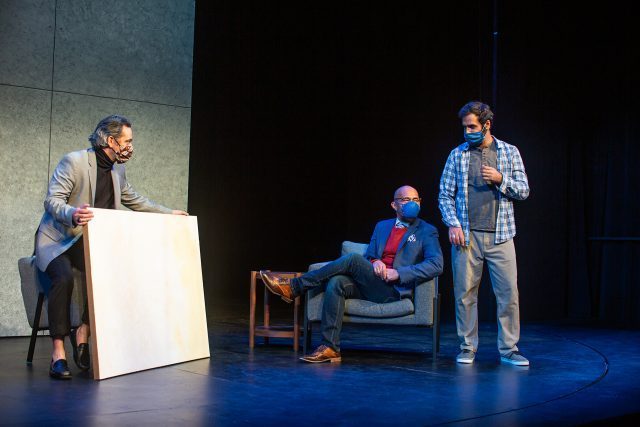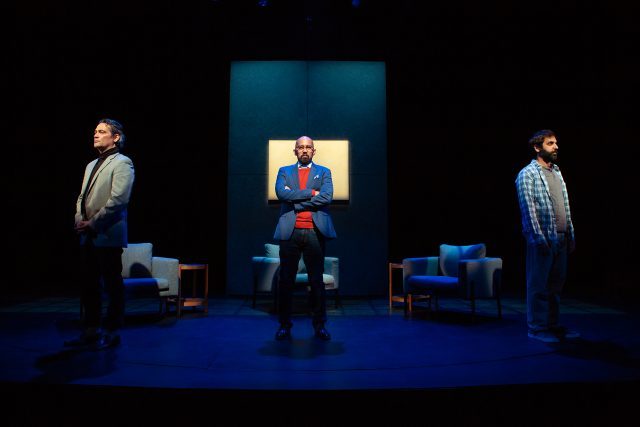
The cast of ‘Art’ rehearsed in masks before filming Tony-winning play onstage together
‘ART’
San Francisco Playhouse
Through November 7, $15-$100
www.sfplayhouse.org
Perhaps the two most important members of the crew of San Francisco Playhouse’s streaming revival of ‘Art’ are production manager Maggie Johnson and general manager Danika Ingraham, who also served as the Covid compliance officers. SFP is one of the first companies in the country to get permission from Actors’ Equity to use its physical theater space to stage a play, albeit without an audience, but filmed with three actors and a full, professional crew. The ninety-minute show was rehearsed with masks and regular testing, then filmed with three cameras over three days, following strict guidelines. Yasmina Reza’s play, which won a Tony in 1998, is a natural for the pandemic, with organic social distancing; the cast spends most of the time more than six feet away from one another, in and around three chairs, with very limited touching of any kind. Yet SFP artistic director Bill English was already considering putting on the play prior to the lockdown, as the work’s central conceit serves as an apt metaphor for what is going on in America today.
Originally written in French and translated by Christopher Hampton (Les Liaisons Dangereuses, Savages), ‘Art’ focuses on a white painting purchased for $200,000 by the erudite Serge (Johnny Moreno). His best friend, the cynical Marc (Jomar Tagatac), thinks it’s a “piece of shit.” Their other friend, the more middlebrow Yvan (Bobak Bakhtiari), who is about to get married, is caught in the middle; Marc desperately wants him to admit to Serge that the painting is terrible, but Yvan doesn’t want to offend Serge, regardless of what he really thinks of the work. Their fifteen-year friendship threatens to crumble as they all start saying things they are likely to regret.

Serge (Johnny Moreno), Marc (Jomar Tagatac), and Yvan (Bobak Bakhtiari) argue over more than just a painting in SFP revival
But there’s a reason the title, ‘Art,’ is in quotes. It is not really about whether an abstract painting by a supposedly famous artist is any good, about what qualifies as ‘art.’ It’s about how difficult it has become to remain civil with people who do not share the same likes and dislikes, the same beliefs, you do. Marc is so upset that Serge has bought the white painting that he is ready to lose him forever. Although Reza (God of Carnage, Life x 3) wrote the play in 1994, it has a timeless quality; the white painting is essentially a blank canvas for the audience to fill in as they please. In 2020, for example, you can imagine it as an electoral map of blue and red states, with three friends arguing over what’s best for the country, willing to end their relationships if they are not voting for the same candidate. During the coronavirus crisis, it’s happening every day over social media, with former high school classmates, family members, and best friends fighting over the virus, immigration, health care, foreign policy, and the economy; they might block one another on Facebook, but they also might not be so willing to meet face-to-face once this crisis is over and go to a museum together.
The English-language version was originally performed by three white men, Albert Finney, Tom Courtenay, and Ken Stott, in London in 1996; the 1999 Broadway premiere featured Alan Alda as Marc, Victor Garber as Serge, and a Tony-nominated Alfred Molina as Yvan. SFP’s diverse casting adds an innate twist to the proceedings as Moreno, Tagatac, and Bakhtiari form a quick camaraderie even amid their characters’ growing displeasure with one another. (It also answers the rhetorical question director English asks in a program note: “Why open our 2020/2021 season with a play written for three white men and their petty upper-middle-class quarrel over a work of art?”)
It’s truly wonderful to finally see a fully staged production, with actual costumes (by Randy Wong-Westbrooke), sound (by Teddy Hulsker), lighting (by Heather Kenyon), and a real set; in addition to the three comfy armchairs, there is a three-sided wall that spins around in the back before stopping to delineate which man’s apartment we are at in each scene. Both Marc and Yvan have small, framed paintings on their wall, while Serge’s is empty, perhaps to be covered by his five-foot-by-four-foot investment. The final stream is effectively edited by Wolfgang Wachalovsky, who puts you onstage with the actors; it was not shot to make you feel like you are sitting in the theater. And until we are allowed back into theaters to see live forms of “art,” this is about as close as we’re going to get.